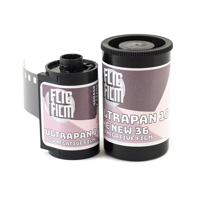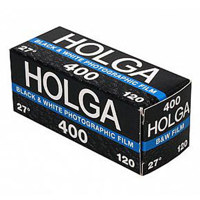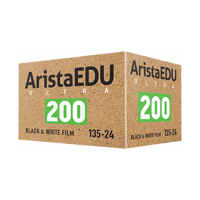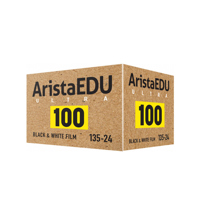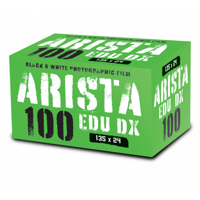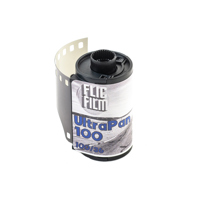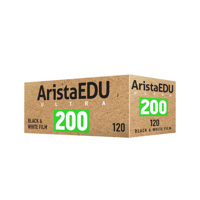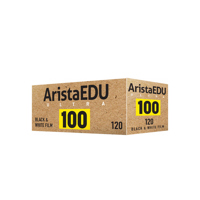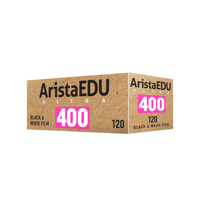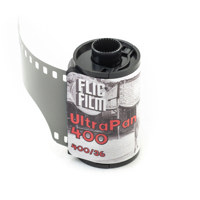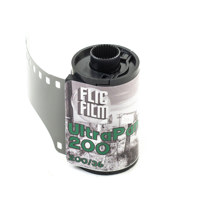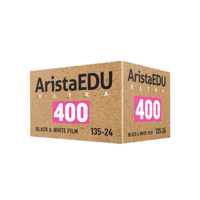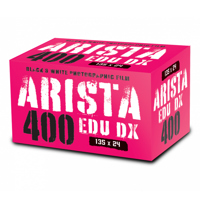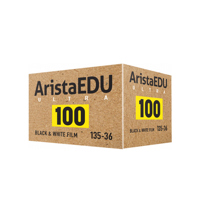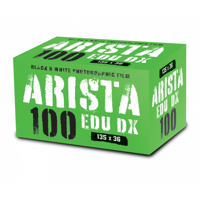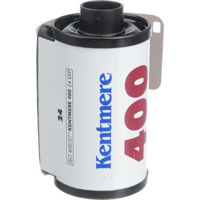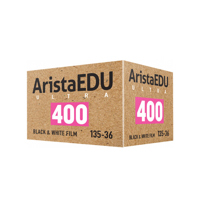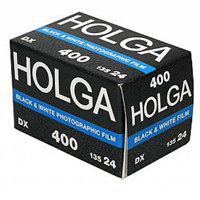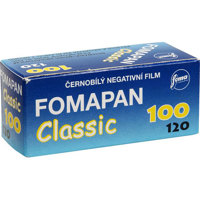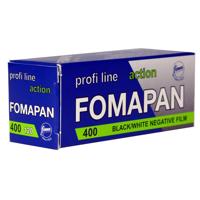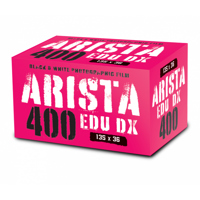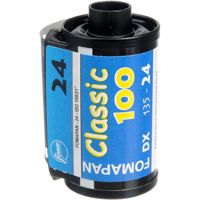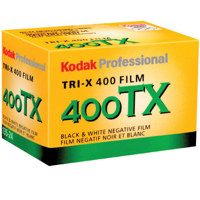Photographic Film
399 resultsSave 5% Every Day† with the Adorama Edge Card. Learn More
Flic Film UltraPan 18 Panchromatic B&W Negative Roll Film, ASA 400, 18 Exposures
- UltraPan 18: Fine grain black and white film.
- ASA 400 film: Excellent sharpness, wide latitude.
- Panchromatic film: Superb archival quality.
- B&W negative film: Ideal for push processing.
- High contrast film: 36 half-frame exposures.
On Backorder
Holga 120 Black and White Film
- Holga 120 Black and White Film: Fine Grain, ISO 400.
- Achieve high sharpness with this B&W negative film.
- Enjoy wide exposure latitude for creative control.
- Standard black and white chemistry processing.
- Push/Pull processing: +/- 1 EV exposure range.
On Backorder
Arista EDU Ultra 200 B&W Negative Film, 35mm Roll Film, 24 Exposures
- Achieve archival quality with B&W negative film.
- Excellent sharpness with fine grain 35mm film.
- Wide latitude B&W film for versatile exposures.
- ISO 200 speed film; standard black & white process.
- High contrast B&W film; 24 exposures per roll.
Arista EDU Ultra 100 B&W Negative Film, 35mm Roll Film, 24 Exposures
- Arista EDU Ultra 100: Fine grain, sharp B&W film.
- 35mm black and white film: Wide latitude, great tones.
- ISO 100 film: Excellent sharpness and high contrast.
- B&W negative film: Push/pull for creative control.
- Arista black and white film: Archival quality film.
Arista Freestyle EDU DX 100 35mm Black & White Negative Roll Film, 24 Exposures
- Excellent sharpness with fine grain black & white film.
- Wide latitude 100 ISO film for versatile exposures.
- Achieve high contrast with standard B&W processing.
- Ideal for push processing; get creative with Arista film.
- Archival quality ensures lasting black & white images.
Flic Film UltraPan 100 35mm B&W Negative Roll Film, ASA 100, 36 Exposures
- Panchromatic B&W film: Fine grain, high sharpness.
- 35mm black and white film: Wide exposure latitude.
- ASA 100 film: Excellent for push processing needs.
- Achieve archival quality with this B&W negative.
- 36 exposures: Capture moments with high contrast.
Arista EDU Ultra 200 B&W Negative Film, 120 Roll Film
- ISO 200 black and white film: Fine grain quality.
- 120 roll film: Wide latitude for diverse conditions.
- Achieve good sharpness with this B&W negative film.
- Standard black and white chemistry for easy process.
- Push/pull ability: Arista EDU Ultra 200 film.
Arista EDU Ultra 100 B&W Negative Film, 120 Roll Film
- Exceptional tonality with Arista B&W film.
- Achieve fine grain with ISO 100 black & white film.
- Wide latitude ensures optimal exposure control.
- Push processing capabilities for versatile use.
- Archival quality B&W film for lasting prints.
Arista EDU Ultra 400 B&W Negative Film, 120 Roll Film
- Arista EDU Ultra 400: Classic B&W Film Stock.
- Achieve fine grain with this ISO 400 black & white film.
- Wide latitude film ensures excellent tonal range.
- Experience good sharpness in your B&W photography.
- Push processing yields unique contrast effects.
On Backorder
Flic Film UltraPan 400 35mm B&W Negative Roll Film, ASA 400, 36 Exposures
- UltraPan 400: Fine grain, sharp B&W film images.
- 35mm Black and White Film: Wide latitude, great tonality.
- ASA 400 Film: Excellent push/pull ability, very versatile.
- Panchromatic Film: Archival quality for lasting prints.
- B&W Negative Film: High contrast, classic film look.
Flic Film UltraPan 200 35mm B&W Negative Roll Film, ASA 200, 36 Exposures
- UltraPan 200: Fine grain B&W film, high sharpness.
- 35mm Black and White Film: Wide latitude, ASA 200.
- Panchromatic Film: Excellent pushability, 36 exposures.
- Archival Quality: Ensures lasting black & white images.
- Standard B&W Chemistry: Easy film processing at home.
On Backorder
Arista EDU Ultra 400 B&W Negative Film, 35mm Roll Film, 24 Exposures
- Arista EDU 400: Fine grain B&W film, superb quality.
- 35mm black and white film: Wide latitude, ISO 400 speed.
- Achieve archival quality with this B&W negative film.
- Excellent sharpness: Perfect for push processing needs.
- High contrast B&W film: 24 exposures per 35mm roll.
Arista EDU Ultra 200 B&W Negative Film, 35mm Roll Film, 36 Exposures
- Achieve archival quality with B&W negative film.
- Experience wide latitude in diverse lighting conditions.
- Excellent sharpness with Arista 35mm roll film.
- Fine grain ensures detailed B&W film results.
- ISO 200 speed offers high contrast and versatility.
Arista Freestyle EDU DX 400 35mm Black & White Negative Roll Film, 24 Exposures
- Classic Black and White Film: 24 Exposures, 35mm.
- ISO 400 Film Speed: Superb Versatility in Various Conditions.
- Panchromatic B&W Negative Film: Fine Grain Quality.
- Excellent Tonality: Achieve Rich, Detailed B&W Images.
- Standard Black and White Chemistry Processing Required.
Arista EDU Ultra 100 B&W Negative Film, 35mm Roll Film, 36 Exposures
- Classic B&W Film: Fine grain, ISO 100 speed.
- 35mm Film: 36 exposures, standard black & white.
- Achieve good tonality with Arista EDU Ultra 100.
- Wide latitude B&W negative film for push/pull.
- Archival quality: Long-lasting black & white film.
Arista Freestyle EDU DX 100 35mm Black & White Negative Roll Film, 36 Exposures
- Classic Black and White Film, 36 Exposures.
- Fine Grain 35mm Film, Excellent Archival Quality.
- ISO 100 Film: Wide Latitude, Great Sharpness.
- High Contrast B&W Film for Stunning Results.
- Push/Pull Processing for Creative Control.
On Backorder
Kentmere 400 Black and White Negative Film, 35mm, 24 Exposure, 6012379
- Kentmere 400 Film: Classic black and white tones.
- 35mm Film: Delivers high contrast, fine grain images.
- B&W Film: Wide latitude for versatile exposures.
- Black and White Film: Excellent sharpness assured.
- Kentmere Film: Pushable for varied lighting needs.
Kodak Kodacolor Gold 200 Negative Film ISO200, 24 Ex, USA
- Kodak Gold 200: Vivid color saturation, fine grain.
- 35mm Color Film: Ideal for daylight photography.
- ISO 200 Film: Excellent sharpness, great results.
- 24 Exposure Film: Capture memories with ease.
- Kodacolor Gold: Wide exposure latitude, forgiving.
Arista EDU Ultra 400 B&W Negative Film, 35mm Roll Film, 36 Exposures
- Achieve archival quality with B&W negative film.
- Experience wide latitude in your B&W film shots.
- Capture fine grain images using this 35mm film.
- Benefit from good sharpness in every 35mm exposure.
- Push processing possible with ISO 400 black & white.
Holga 135-24 Black and White Film
- Capture stunning images with ISO 400 black and white film.
- Achieve fine grain and exceptional sharpness in every shot.
- Enjoy wide exposure latitude for versatile photography.
- Experience classic tonality with Holga black and white film.
- Perfect for general purpose and standard B&W processing.
Foma Film Fomapan 100 Classic Black and White Negative Film, 120 Roll, 60mm Wide
- Fomapan 100: Classic black and white film, 120 roll.
- Fine grain film delivers exceptional image sharpness.
- Wide latitude film ensures versatile exposure control.
- Achieve high contrast negatives with ISO 100 film.
- Excellent for push processing, expand creative options.
Foma Film Fomapan 400 Action Black & White Negative Film, 120 Roll, 60mm Wide
- Fomapan 400: Classic black and white film.
- ISO 400 film: Excellent sharpness and fine grain.
- 120 roll film: Wide latitude for push/pull.
- Achieve high contrast with B&W negative film.
- Exceptional archival quality for lasting prints.
Arista Freestyle EDU DX 400 35mm B&W Negative Roll Film, 36 Exposures
- Classic B&W Film: Achieve timeless monochrome images.
- 400 ISO Film: Excellent for versatile shooting needs.
- 35mm Film: Standard format, ensuring broad compatibility.
- Fine Grain Film: Capture sharp details with clarity.
- Black and White Film: Perfect for artistic expression.
Special Order
Foma Film Fomapan 100 Classic 35mm Black and White Negative Film, 24 Exposures
- Classic black and white film, fine grain quality.
- ISO 100 film speed, wide latitude for exposures.
- 35mm film, 24 exposures, archival quality film.
- Excellent sharpness, high contrast in your images.
- Pushability allows versatile film development.
On Backorder
Kodak Tri-X Pan 400, Black & White Negative Film 35mm Size, 24 Exposure
- High Sharpness: Kodak Tri-X 400, 35mm Film.
- Fine Grain: Achieve superb image quality, ISO 400.
- Wide Latitude: Excellent exposure range, B&W Film.
- Exceptional Tonality: Rich blacks, bright whites.
- Push Processing: Flexible development options film.
Temporarily On Backorder
While contemporary photography is dominated by everything digital, that does not mean that analog photography has completely lost its relevance. In fact, many photographers who’ve grown tired of the instantaneous nature of digital photography are using film cameras to realize their creative vision.
Expand Your Artistic Vision with Film Photography
The past few years have seen the revival of iconic films from legacy brands like Polaroid and Fujifilm. Film cameras are also more affordable than many of their digital counterparts and are readily available at online and physical stores. This, in turn, has piqued the interest of members of the photography community who wish to expand their creative repertoire.
Advantages Of Film Photography
Some of film photography’s limitations are no longer treated as shortcomings but are now viewed as advantages. For instance, while shooting with a digital camera and an expansive memory card allows photographers to snap away liberally, users only get about 24 to 36 frames with a film camera. Some photographers like this because it forces them to be more meticulous and study every shoot carefully before pressing the shutter.
The resulting images are also often startlingly different from those produced by digital cameras. The different chemicals used in film influence how it renders light and color, with some films known for producing sharp images that are difficult to differentiate from digital images. Others produce more subdued colors or contrasted images, which may be the aesthetic the photographer is going for.
Experiment with Color Film & Black and White Film Photography
Apart from the chemicals found in photographic film, the developing process can also alter the intensity of exposure and colors. Some of the most popular developing processes include E-6 for color film slides and C-41 for color negatives. In order to produce the cross-processing effect (commonly employed in Lomography), some photographers will develop C-41 films with E-6 chemicals and vice versa. This results in images with high saturation and contrast, as well as unpredictable features, like light leaks, overexposure, and vignettes.
What Is The Difference Between 35mm Film And Large Format Film?
Photographic film comes in many different sizes and ratios. 35mm refers to the physical size of the film strips themselves. While 35mm film rolls can come in many lengths, the width of the film is always 35mm. Large-format film reflects a larger physical size like 4x5, 5x7, or 8x10 inches.
35mm film traditionally comes rolled up in a film cartridge that you can easily load into a 35mm camera, and large-format film usually comes as individual sheets or plates. Photographers load these sheets into film holders, which then go into the large-format camera. Large-format film is loaded and exposed one shot at a time.
What's The Difference Between 35mm And Medium Format Film?
Medium-format film is slightly larger than 35mm film, but it’s also smaller than large-format film. You may see medium-format film referred to as 120 film. This film type actually includes a few different physical dimensions: 6x4.5, 6x6, and 6x7 centimeter frames are all different types of 120 medium-format film.
Like 35mm film, 120 film also comes rolled in cartridges, but the film rolls usually have fewer exposures per roll. You may not find quite as many varieties of 120 film as you do 35mm because 35mm is simply the most common size. As a result, film manufacturers offer more styles and ISOs for this film type.
What Is 35mm Best Used For?
You can use 35mm film for just about any photographic subject or situation. The important thing to remember when using 35mm film is that the film’s light sensitivity is reflected in its ISO. You will need to adjust your shutter speed and aperture to suit your available light and film speed.
Because film 35mm negatives are physically smaller than medium or large-format negatives, you may not see as much detail in each exposure. If you’re looking for a highly detailed enlargement of a landscape or portrait, large-format negatives are often the best option.
How To Develop 35mm Film
Developing 35mm film is a very specific but fairly simple process as long as you have all the supplies. You’ll need a film developing tank, a light-proof bag, water, developer, stop bath, and fixer. Photographers who don’t enjoy dealing with chemicals sometimes take their film to a photo lab and then scan the negatives for digital processing.
Developing color film is much more complex than developing black-and-white film. You’ll need specialized gear and extra chemical steps. You can read more about the step-by-step processes for film developing in our article on How To Develop Film.
Shop for Premium Photographic Film at Adorama
Eager to expand your creative vision with film photography? Adorama stocks a wide variety of black and white film, color film, instant film, specialty film, and film accessories. We carry film from some of the most reputable brands, including Polaroid Originals, Arista, and Foma. We also carry instant film for Fujifilm Instax and Polaroid cameras, and specialty films like infrared film and black and white reversal film. Filter your specifications on the left-hand side of this page to narrow down your choices.
